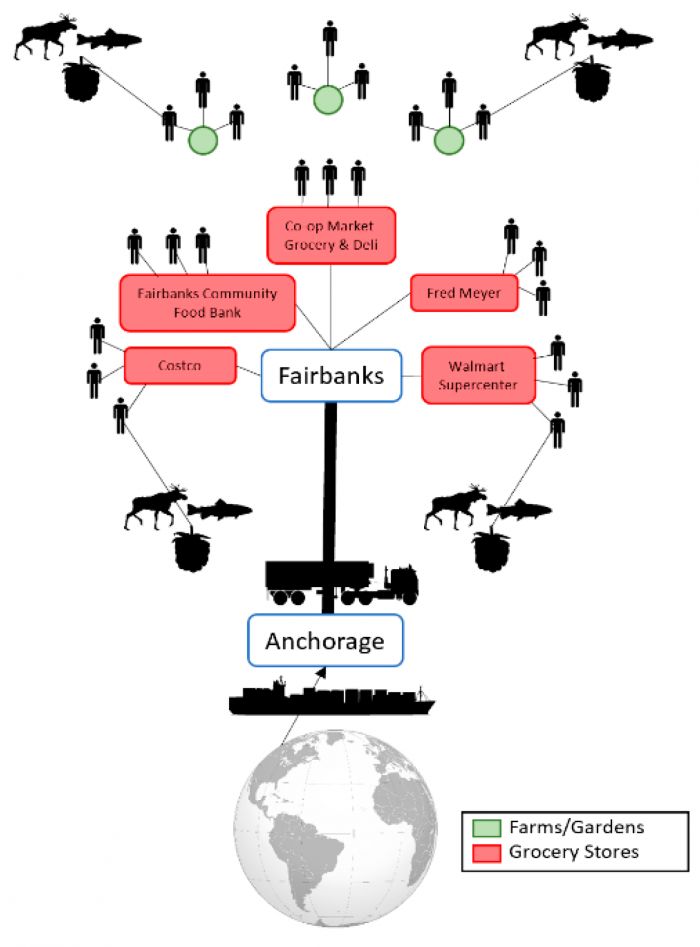By: Robert Orttung, George Washington University, Washington, D.C.
Reliable food supply is a central concern for residents of cities located in remote locations with extreme climate conditions. In our work supported by the Promoting Urban Sustainability in the Arctic project, we examined how stake-holders in such northern cities ensure a high level of food security using a case study of the Fairbanks North Star Borough, Alaska, which is located in the interior of the state near the Arctic Circle.
A team made up of academics, a student, and a member of the Fairbanks North Star Borough Sustainability Commission recently joined forces to examine how they could better work together to address pressing community issues in interior Alaska. Food security was among key concerns according to a series of interviews with 21 stakeholders and the results of meetings among the Commission and constituents.
Through our work in Fairbanks we hope to develop a prototype of a model that could be applied in other Arctic and near-Arctic cities. Given the extensive intellectual resources and community engagement in Fairbanks, the work offers something of a most likely case for success and hopefully the innovations developed there can point the way forward for other cities as well.

It is believed that 95% of food purchased by residents of Alaska comes from out-of-state, leading to concern among community members about what might happen if the supply chain were cut off by a disaster. Of course, generally speaking, the food system works just fine for most people most of the time. But it makes a lot of sense to think about the hazards facing the food system and their possible impact on different categories of citizens, including the most vulnerable, in times of crisis. Our recent article Strengthening Food Security Near the Arctic Circle: Case Study of Fairbanks North Star Borough, Alaska in the journal Sustainability examines these issues and a process for bringing together stakeholders to address them. Increasing local food production, for example, would have the added benefit of expanding the number of jobs in the area.
At the heart of the study was the basic research question of how policy makers, academics, and the general public can develop strategies for managing food security challenges through a focus on data. The research was funded by a grant from the National Science Foundation as part of a larger project examining urban sustainability in 50 Arctic cities. The focus on data is important because they could help provide common ground for stakeholders who pursue different values or do not agree on broader strategic objectives. Data, in theory, can provide a basis for policies that help improve the situation at the local level.
Our overall research approach is to apply the international standard for sustainable cities (ISO 37120) to 50 Arctic cities. We hope to measure the sustainability of each Arctic city, but also to determine how those cities differ from non-Arctic cities. By gathering all this data, we hope to give city decision makers and stakeholders an objective set of information on how their city is performing and what areas could be improved. By showing how things work around the world, we hope that our project will identify best practices that can be transferred from one city to others. Part of the effort is to develop dashboards that effectively communicate community goals in the area of food security and progress toward achieving them.
We are trying to collect data measuring 128 indicators for 50 cities, meaning 6,400 data points. We are about two-thirds of the way there. So far, our preliminary analysis shows that the Scandinavian cities are among the best performers, with the U.S. and Canada in the middle, and Russia facing the most challenges. But there is lots of variation among the cities and within these broader regions. We hope that the more detailed and comprehensive data will give us much more nuanced results than are available today.
Our preliminary analysis suggests that Scandinavian cities excel because they make the most of the resources available to them. Citizens actively participate in all aspects of public life and work closely with social organizations, government, and private enterprise to produce results that benefit all members of society. Sweden recently published a National Food Strategy seeking to make its regulations more effective in spurring competition, give consumers more confidence in their food choices, and stimulate more innovation in the food supply chain and the production and consumption of food.
For more information, please see our project website.We plan to make the data public so that other researchers can use it for their own projects and hopefully update it over time.
Please contact the project PI Robert Orttung (rorttung [at] gmail.com) for further information.
About the Author

Robert Orttung is the Director of Research for Sustainable GW and a Research Professor of International Affairs at the Elliot School of International Affairs at George Washington University. He earned a PhD in political science from the University of California, Los Angeles in 1992. Since then he has published on Russian politics, energy, mega-projects, and Arctic developments. His current research interests include urban sustainability, Arctic geopolitics, Russian propaganda, democracy, and finding ways to make team science more effective.
